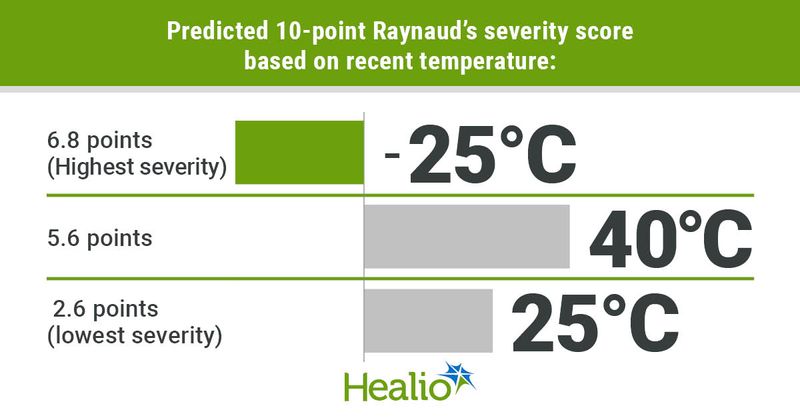Raynaud’s disease most severe at very low temperatures, also ‘troublesome’ above 35°C
Key takeaways:
- Raynaud’s can also be “particularly troublesome” in warm climates when moving between air-conditioned buildings.
- Future research could include wearable devices and apps to track temperature and attacks.
The severity of Raynaud’s disease is greatest at very low temperatures, but can also increase in hot environments that reach 35°C and above, according to data published in The Lancet Rheumatology.
The increase in severity at higher temperatures is “presumably due to air conditioning,” the researchers wrote. They added that Raynaud’s disease was least severe at 25°C.

“Almost everybody with scleroderma has Raynaud’s phenomenon, and they often discuss the role of temperature and how much it affects them,” Brett D. Thombs, PhD, of the Lady Davis Institute for Medical Research, at Jewish General Hospital, in Montreal, told Healio. “There was not, though, data from any studies on the degree that Raynaud’s affects people across the range of temperatures, so we attempted to address this issue.”
To assess Raynaud's severity in relation to temperature, Thombs and colleagues used patient-reported data from the Scleroderma Patient-centered Intervention Network Cohort, as well as data from weather stations nearest to each patient’s recruiting center. Their analysis included 2,234 patients (mean age, 54.8 years) with Raynaud’s disease secondary to systemic sclerosis.
Patients reported Raynaud’s severity over the previous week on a scale of 0 to 10 at 3-month intervals. Each patient’s severity was compared with mean daily temperature, as well as a “feels-like” temperature accounting for wind chill and humidity, using linear mixed models. The researchers reported the predicted severity of Raynaud’s disease, and the predicted difference for each 5°C interval, for temperatures from –25°C (-13°F) to 40°C (104°F).
According to the researchers, the greatest predicted severity for Raynaud’s disease was a score of 6.8 points (95% CI, 5.6-8.1), at –25°C. Meanwhile, the minimum was 2.6 points (95% CI, 2.5-2.7), at 25°C. Severity decreased at every 5°C interval from –25°C to 25°C (77°F). The researchers described the decreases as:
- “large” between –25°C and –15°C (0.63 to 1.41 points per 5°C difference);
- “small” between –15°C and 5°C (0.05 to 0.21 points); and
- “moderate” between 5°C and 25°C (0.37 to 0.54 points).
According to the researchers, scores also increased at temperatures above 25°C, to 3.5 points (95% CI, 3-4.1) at 35°C and to 5.6 points (95% CI, 4.5-6.8) at 40°C.
All results were similar for the “feels-like” temperature, the researchers wrote.
“Our study confirms that Raynaud’s attacks occur at all temperatures despite steps that many people take to prevent them,” Thombs said. “Many clinicians, however, might not be aware that Raynaud’s can be particularly troublesome in very warm climates where people move between hot outdoor temperatures and very cold temperatures in air-conditioned buildings.
“Thus, in addition to advising patients to take steps when it is cold outside, it would be helpful for people with Raynaud’s to prepare for different outdoor and indoor environments in hot climates, as well,” he added.
According to Thombs, future research could involve wearable devices and apps to track temperatures and Raynaud's attacks “live.”
“This type of observational study could also provide insight on strategies that might help to reduce the impact of the condition,” he said. “Of course, we need to advance options that people have for managing Raynaud's phenomenon. Available medication treatments aren’t particularly effective, and we don’t know very much about non-pharmacological management. We should work to change that.”
For more information:
Brett D. Thombs, PhD, can be reached at brett.thombs@mcgill.ca.
